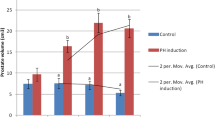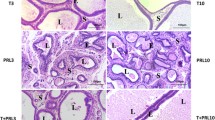Summary
To investigate the effect of anti-androgens on BPH, Oxendolone (OXD), a pure anti-androgen, was tested in experimentally induced BPH in 17 beagle dogs, alone or in combination with medroxyprogesterone acetate (MPA) which displays both anti-androgenic and anti-estrogenic activity. The relatively early stage of canine BPH was induced by administration of 3α-androstanediol (3α-A) plus estradiol (E2) for 6 months and followed by testosterone propionate (TP) plus E2 for another 6 months during the anti-androgenic treatment. By the manipulation with T, a decrease in volume of glandular component associated with a relative increase in stromal tissue was achieved, which mimics human BPH histology. The prostate substituted with T and E2, however, gradually decreased in size. Therefore the effect of OXD or OXD+MPA was not significant agianst the untreated controls (T-E control). The weight of the prostate in these OXD±MPA groups was however significantly reduced as compared to that of BPH controls which received 3α-A and E2 throughout the experimental period. On histological examination, atrophic changes were observed in the hormone-treated groups compared to the T-E control. The finding was the most striking in the OXD+MPA group with small non-involuted acini scattered in the abundant stromal tissue. This was almost identical to the appearances of castrated control groups. Atrophy may be due not only to the anti-androgenic but also to the anti-estrogenic property of MPA. A report on the hormonal background of this experiment will appear in the second article.
Similar content being viewed by others
References
deKlerk DP, Coffey DS, Ewing LL, McDermott IR, Reiner WG, Robinson CH, Scott WW, Strandberg JD, Talalay P, Walsh PC, Wheaton LG, Zirkin BR (1979) Comparison of spontaneous and experimentally induced canine prostatic hyperplasia. J Clin Invest 64:842–849
Funke P-J, Tunn UW, Senge Th, Neumann F (1982) Effects of the antioestrogen tamoxifen on sterioid induced morphological and biochemical changes in the castrated dog prostate. Acta Endocrinol (Copenh) 100:462–472
Furr BJ, Patterson JS, Richardson DN, Slater SR, Wakeling AE (1979) Tamoxifen. In: Goldberg ME (ed) Pharmacological and biochemical properties of drug substances. American Pharmaceutical Association, New York, pp 355–399
Goto G, Hiraga K, Miki T Sumi M (1983) An alternative synthesis of 16β-ethyl-17 β-hydroxyestr-4-en-3-one (Oxendolone). Yakugaku Zasshi 103:1042–1045 (Japanese)
Huggins C, Clark PJ (1940) Quantitative studies of the prostatic secretion. II. The effect of castration and of estrogen injection on the normal and on the hyperplastic prostate glands of dogs. J Exp Med 72:747–761
Huggins C (1947) The etiology of benign prostatic hypertrophy. Bull NY Acad Med 23:696–704
Jacobi GH, Moore RJ, Wilson JD (1978) Studies on the mechanism of 3α-androstanediol-induced growth of the dog prostate. Endocrinology 102:1748–1755
Masuoka M, Masaki T, Yamazaki I, Hori I, Nakayama R (1979) Hormonal spectra of anti-androgen TSAA-291 (16β-ethyl-17β-hydroxy-4-oestren-3-one) and its derivatives. Acta Endocrinol (Copenh) [Suppl] 92 229:36–52
Moore RJ, Gazak JM, Quebbeman JF, Wilson JD (1979) Concentration of dihydrotestosterone and 3α-androstanediol in naturally occuring and androgen-induced prostatic hyperplasia in the dog. J Clin Invest 64:1003–1010
Nakayama R, Masuoka M, Masaki T, Shimamoto K (1979) Antiandrogenic effect of a new steroid TSAA-291 (16β-ethyl-17 β-hydroxy-4-oestren-3-one) and its derivatives. Acta Endocrinol (Copenh) [Suppl] 92 229:2–23
Pannuti F, Martoni A, Camaggi CM, Strocchi E, Di Marco AR, Rossi AP, Tomasi L, Giovannini M, Cricca A, Fruet F, Lelli G, Giambiasi ME, Canova N (1982) High dose medroxyprogesterone acetate in oncology. History, clinical use and pharmacokinetics. In: Cavalli F, McGuire WL, Pannuti F, Pellegrini A, Robustelli Della Cuna G (eds) Proceedings of the International Symposium on Medroxyprogesterone Acetate. Excerpta Medica, Amsterdam, pp 5–43
Sudo K, Yoshida K, Kimura Y, Nakayama R (1979) Effect of the anti-androgen TSAA-291 on the androgen-receptor complex formation from (3H)testosterone in rat ventral prostates. Acta Endocrinol (Copenh) [Suppl] 92 229:67–81
Tseng L, Gurpide E (1975) Induction of human endometrial estradiol dehydrogenase by progestins. Endocrinology 97:825–833
Tunn U, Senge Th, Schenck B, Neumann F (1979) Biochemical and histological studies on prostates in castrated dogs after treatment with androstanediol, oestradiol and cyproterone acetate. Acta Endocrinol (Copenh) 91:373–384
Tunn UW, Schuering B, Senge Th, Neumann F, Schweikert HU, Rohr HP (1980) Morphometrical analysis of prostates in castrated dogs after treatment with androstanediol, estradiol, and cyproterone acetate. Invest Urol 18:289–292
Walsh PC, Wilson JD (1976) The induction of prostatic hypertrophy in the dog with androstanediol. J Clin Invest 57:1093–1097
Yoshida O, Okada K, Shida K, Kondo A, Saito Y, Tsuji I, Kumamoto Y, Orikasa S, Shimazaki J, Mitsuya H, Kuroda K, Omori H, Nihira H, Momose S, Sakuma A (1979) Clinical evaluation of TSAA-291 in treatment of benign prostatic hyperplasia by double blind study. Acta Urol Jpn 25:1077–1108 (Japanese)
Yohida O, Okada K (1984) Clinical effect of gestonorone caproate on prostatic hypertrophy: a double blind study. Current Ther Res 35:139–155
Author information
Authors and Affiliations
Rights and permissions
About this article
Cite this article
Okada, K., Oishi, K., Yoshida, O. et al. Study of the effect of an anti-androgen (Oxendolone) on experimentally induced canine prostatic hyperplasia. Urol. Res. 16, 67–72 (1988). https://doi.org/10.1007/BF00261958
Accepted:
Issue Date:
DOI: https://doi.org/10.1007/BF00261958




